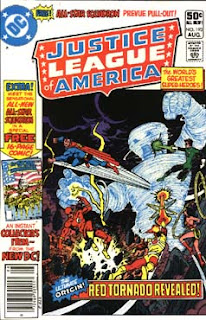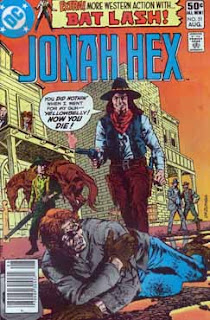I'm reading DC Comics' output from January 1980 (cover date) to Crisis! I'm a couple of days later than my usual Wednesday post, but I'm looking at the comics at newsstands on the week of May 7, 1981.
Batman #338: Conway/Thomas and Novick/McLaughlin put Batman up against a villain whose a master athlete with various sports-theme gimmicks. No, it's not the Sportsmaster (he's on Earth-2). This guy hates sports and is killing sports stars and journalists. It turns out he had a dad who really pushed him into sports as a kid, but not just in the usual way. He injected him with his own sort of super-athlete serum. His mom, reasonably viewing this as child abuse whisked the kid away, but the damage was done. The Sportsman is a super-athlete, but his achievements were tainted by him knowing they were chemically induced and the enhancements caused him to develop fatal cancer. This adds up to a workman-like Batman tale, with a one appearance (I assume) villain.
The Conway/Newton Robin backup solves the murder mystery in the big top, and I guess it's a twist I didn't see coming, but then I also stopped carrying about this story a couple of installments ago.

DC Comics Presents #36: Because someone demanded it (maybe) Levitz circles back to wrapped up the story of Starman which was abandoned with the switch in Adventure Comics months ago. This time he's got a more suitable artist perhaps in the form of Starlin. Starlin's Mongul comes along to be the heavy. Some time has apparently passed since we last saw Starman because now he's gotten the throne that previously belonged to his sister (who didn't know she was his sister) upon her death. Mongul assassinated her and then married Starman's lady love Merria because he knows the wearer of the crown of Throneworld has access to a planet destroying super-weapon and an empire. Starman teams up with Superman to put a stop to all this. Interestingly, the story doesn't end with the "rightful king" being restored, but rather the dissolution of the empire and Starman destroying the doomsday device his ancestors had used to coerce obedience.

Flash #300: This special oversized issue, mostly is an excuse for Bates and Infantino to recap the origins of the Flash, Kid Flash, his Rogues, and even his friend Elongated Man. Absent this filler, though the core story isn't bad. The bandaged guy in a hospital bed we've seen over a couple of issues who was named Barry Allen, turns up to be the Barry Allen. He's visited by a new psychiatrist that looks a lot like his father due to Infantino's art, but anyway the doctor is trying to convince Allen that the Flash is a delusion and that the accident with the chemicals left him horrible scared and paralyzed instead of making him a superhero. Allen is convinced this is a villainous plot (he's right) but the villains play a pretty convincing game until right up to the end, when the Flash turns the tables and exposes Abra Kadabra as the mastermind. The reveal makes the story seem "smaller" than its anniversary issue page count would warrant, but it's well-crafted one of the puzzle sort.

Ghosts #103: The lead story here is one of the best so far this year. A group of kids in a hospital unit sneak into the the room of one of their peers to perform a séance to determine the cause of the kid's mysterious coma that has the doctors baffled. It turns out the boy's spirit is considering leaving his body as he lost his mother in the accident that put him in the hospital and is now an orphan. He even tries to draw away the spirit of another little girl to come with him. The group holds strong and convinces the boy not to leave life yet. In the morning, he miraculously awakens from the coma and the kids are found sleeping in a circle around his bed. Levitz's kid dialogue here is occasionally schmaltzy in a Twilight Zone sort of way, but Spiegle draws kids well and really makes it work.
It's downhill from there. Allikas and Gonzales give us an EC-esque potboiler about the ghost of a murdered man getting revenge on the crook how murdered him who attempts now to rob the dead man's grave in search of a value ring. Snyder and Gonzales supply a take that would have perhaps been better suited to one of DC's short lived "gothic romance" titles of the 70s, where an elderly woman gets to be reunited in death with her departed husband after showing her psychiatrists that ghosts do exist.

G.I. Combat #232: Kanigher's and Glanzman's first Haunted Tank story has Jeb replaced by a lookalike German assassin sent to kill Patton. It turns out Patton can see the ghost of J.E.B. Stuart, too, who warns him off-screen. The second story has the crew taking a castle back from the Germans, and being forced to resort to Medieval weaponry after the tank lands in the moat. Whether war comics are made better by this sort of "high concept" stuff is difficult to say. I do like G.I. Robot! On the other hand, I think the more grounded Sgt. Rock is generally better than the Haunted Tank.
The O.S.S. story introduced Kana, a ninja working for the U.S. In this first story he gets to kill the commander that had his parents executed as American collaborators and also faces some prejudice from the American troops he's fighting alongside. In an "Underwater War" segment, a frogman must stop the German's from salvaging the experimental "laser gun" from a sunken submarine. Apparently in the DCU the term "laser" existed well before 1957. Drake's and Vicatan's "Battling Bard of Co. B" has a Shakespeare professor turned G.I. has it's ostensible hero, but I can see how his constantly quotation and grammarian ways would have irritated guys just trying to stay alive and fight a war, so I can have too much sympathy for him. He does save the day in the end.
Jonah Hex #52: Mei Ling is about to give birth and Hex has to go into town to get a comforter he has secretly purchased for her bed. There's a young wannabe gunslinger there looking to make a name for himself by outgoing the famous bounty hunter. Hex ignores the guy's attempts to goad him by calling him a "coward" but it rankles him because his abusive father did the same thing. When he sees the gunslinger strike a kid, Hex gives him the fight he was looking for, though he doesn't have his six shooters. In the end, the gunslinger is going to Boot Hill, and Hex carries his dirtied, but otherwise okay comforter home to his wife and new child. While these stories aren't much considered today, the comics market being so focused on superheroes, I feel like Fleisher and the artists consistently deliver solid work, pretty much on a the level of sophistication 70s tv primetime Western--which isn't my attempt to damn with faint praise; remember comics in this era were aimed at kids.
The Bat Lash story is actually a follow-up to the tale from a few months back that I thought was a one off. Bat Lash tracks down the woman who stole the deed to the "social club" that he won in the card game. He discovers she's after the club for a stash of Confederate gold. When he tries to confront her and get the deed the "soiled doves" of the social club come to her defense.
































